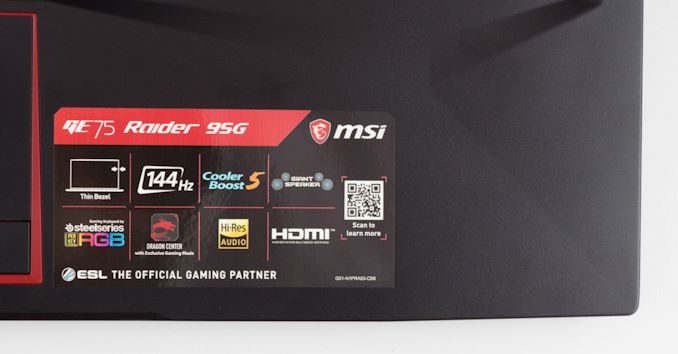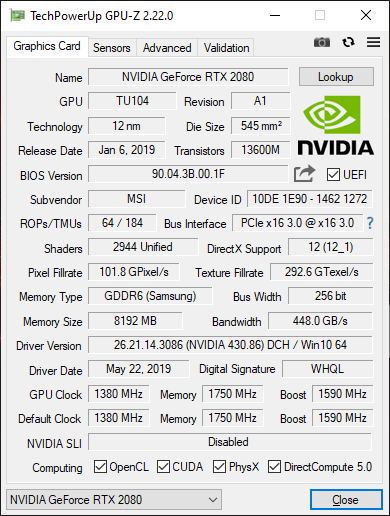The MSI GE75 Raider Laptop Review: Core i9 and RTX 2080 Performance
by Brett Howse on July 12, 2019 8:00 AM EST
MSI went heavily into developing gaming products several years ago, and although the company’s laptop lineup isn’t exclusively gaming, that is by far the biggest portion of their portfolio, and as such we’ve seen some impressive laptops from MSI that offer both performance and quality ahead of their competition. Today we are looking at the latest in their “enthusiast” level of laptops with the MSI GE75 Raider. The GE range isn’t quite at the top end of MSI’s lineup – a spot that is occupied by the GT series – but it still offers prodigious portable performance without being as tied to the desk as a typical GT laptop would be.
The GE75 Raider lineup is a pretty wide range of prices and performance in the 17.3-inch gaming laptop class, offering three GPU choices with the NVIDIA RTX 2060, RTX 2070, and RTX 2080 scaling up the pricing and performance, and CPU ranging from the hex-core Intel Core i7-9750H up to octa-core Intel Core i9-9880H depending on the model. MSI offers up to 64 GB of DDR4 RAM and 2 TB NVMe storage as well. There’s no shortage of choices here with enough range to please anyone in this market.
All the GE75 Raider models ship with a 17.3-inch IPS display. Although the resolution is just 1920x1080, the refresh rate is 144 Hz. Some may lament the lack of a UHD option, but in the laptop space, even the mighty RTX 2080 can still struggle to game at UHD without turning down some of the settings, and for those that haven’t had a chance to try gaming on a high-refresh display, the added smoothness makes for a better experience than higher resolution, at least in my experience. If you really prefer UHD, MSI would be happy to have you step up to their GT range with the GT76 Titan offering such a display.
| MSI GE75 Raider | |||||
| Component | Low | Mid | High Model Tested: Core i9-9880H RTX 2080 32GB DDR4 1TB NVMe |
||
| CPU | Intel Core i7-9750H 6C/12T 2.6-4.5GHz 45W TDP |
Intel Core i7-9750H 6C/12T 2.6-4.5GHz 45W TDP Optional Core i9-9880H 8C/16T 2.3-4.8GHz 45W TDP |
|||
| GPU | NVIDIA RTX 2060 1920 CUDA Cores 6 GB GDDR6 192-bit 26T RTX-OPS |
NVIDIA RTX 2070 2304 CUDA Cores 8 GB GDDR6 256-bit 31-38T RTX-OPS |
NVIDIA RTX 2080 2944 CUDA Cores 8 GB GDDR6 256-bit 37-53T RTX-OPS |
||
| Memory | 16-64 GB DDR4-2666 2 SODIMM Slots |
||||
| Storage | 512GB-1TB NVMe Optional 1TB HDD Optional 2 x 1TB NVMe |
||||
| Display | 17.3-inch 1920x1080 IPS 144 Hz Refresh Rate No G-SYNC |
||||
| Networking | Killer N1550i 2x2:2 802.11ac Wireless Killer E2500 Ethernet Bluetooth 5 |
||||
| I/O | USB Type-C Gen2 x 1 USB Type-A Gen2 x 2 HDMI 2.0 Mini DisplayPort SD Card Slot SPDIF (ESS Sabre HiFi) Headphone jack |
||||
| Keyboard | SteelSeries per-Key RGB Anti-Ghosting |
||||
| Speakers | 3W x 2 Woofers 3W x 2 Subwoofers |
||||
| Battery | 51Wh 180W AC Adapter |
51Wh 280W AC Adapter |
65Wh 280W AC Adapter |
||
| Dimensions | 397 x 268 x 27.4 mm 15.63 x 10.57 x 1.08 inches |
||||
| Weight | 2.61 kg / 5.75 lbs | ||||
| MSRP | $1,799 | $1999-$2899 | $2499-$3399 | ||
The GE75 Raider packs all of this performance into a 17.3-inch chassis that weighs 5.75 lbs, which by no means makes it an Ultrabook, but still provides a level of portability that makes it easy to move from desk to desk. As part of this tradeoff for portability, MSI has chosen to provide NVIDIA Optimus support, meaning the NVIDIA GPU can be turned off when not needed and the laptop runs off the integrated Intel GPU, but the downside to that is the lack of G-SYNC, because G-SYNC requires the display be direction connected to the NVIDIA GPU. There is a solution to this which Acer outfitted in the Predator Triton 500 we reviewed, which is a user-selectable multiplexer to choose which GPU the display connects to, and giving the user the choice of G-SYNC or Optimus, but unfortunately MSI has not gone this route.
Other notable features of the MSI GE75 Raider are both Gigabit Ethernet and 802.11ac wireless in the form of the Killer E2500 and Killer N1550, the latter of which is based on the Intel 9260 and therefore features wide-channel support and up to 1.73 Gbps maximum connection speed, assuming your router supports the wider channels. MSI also outfits the GE75 Raider with speakers they brand as “Giant Speakers” which offer two 3W speakers with two 3W subwoofers. There’s the typical selection of USB ports with two Gen 2 and one Gen 1, as well as a USB Type-C with Gen 2 support, but somewhat surprisingly no Thunderbolt 3 support.
MSI offers some interesting aspects in their design, so let’s dig into that now.












30 Comments
View All Comments
gunnys - Friday, July 12, 2019 - link
The current lack of 4K 17.3" gaming laptops is depressing. We have faster hardware but low res displays.DanNeely - Friday, July 12, 2019 - link
As noted in the article itself, MSI is currently limiting the 17" 4k option to their even higher end and chunkier GT76 series.gunnys - Friday, July 12, 2019 - link
I missed that, thanks for the heads up. But I also meant in general, lack of 4K sucks. I spend way more time not gaming than gaming, and would appreciate higher pixel density in general tasks. Personally I'd be more pleased with 4K at even just 60 Hz. A 120 Hz or 144 Hz panel would be useful just a few hours a month in gaming.And the whole situation makes even less sense when I'm seeing plenty of 15.6" 4K laptops.
I've heard the new Razer Blade Pro will only ship with 4K in it's upcoming Quadro RTX version. It appears manufacturers are reserving 4K for the highest tier only. In that case.... I'll hold off on buying. I don't need a Quadro or a $4000 laptop... just more pixel density. An RTX 2080 or Quadro isn't needed to drive Windows, Office, and Youtube at 2160p.
A decent 17.3" 4K panel wasn't a huge upgrade cost just a year or two ago.
DanNeely - Friday, July 12, 2019 - link
as an ever more niche product line 17" laptops tend to lag badly in any components (like screens) that can't be shared with more plebeian 15" laptops. Volumes of high end 13 laptops are higher than 15" and 15" is higher than 17"; with the result that most of the higher end screen options started at the smallest size where there was more volume to be sold and then worked their way to smaller volume parts only slowly.When I get my next laptop in a year or two I'm hoping to be able to find something with 1440p/144hz at 15". 4k's massive overkill, drives up power consumption. 1440p is good enough for general use and is at least somewhat plausible to game at above 60hz on the occasions I do that instead of just surfing the web.
quiksilvr - Friday, July 12, 2019 - link
I would say not having G-SYNC is the bigger issue.tshoobs - Wednesday, July 17, 2019 - link
I agree that it is sad to still see so many gaming laptops in this class using 1080p - that is really not enough pixel density for a 17.3" screen.For general use, 4k resolution in this screen size still generates a lot of need for scaling which in Windows is as good as it has ever been but still flawed.
I'd love to see a 1440p panel however, I think that would be perfect for the 17.3" gaming laptop. 1080p is very long in the tooth.
ingwe - Friday, July 12, 2019 - link
Given that it is a 144 Hz IPS display with great color accuracy, I think it is still a display to be happy with.weilin - Friday, July 12, 2019 - link
I'd personally prefer QHD (2560x1440) over UHD. Especially for screens smaller than 24". It seems like the best compromise on resolution and performance.quantumshadow44 - Friday, July 12, 2019 - link
Im perfectly fine with 4k on 15" dell m4800.100% srgb/Adobergb
pbollwerk - Friday, July 12, 2019 - link
My current laptop (Alienware 13) has the "near"-4k OLED, and while it looks gorgeous, I don't like the performance hit I get when gaming, and text is unreadable. Maybe 4k is better on a 17", but my next gaming laptop won't be 4k. For gaming, it's not worth it for me.For other tasks, like video/photo editing, I can understand. But this is a gaming laptop.
Having said that, 1080 is too low resolution for modern laptops.